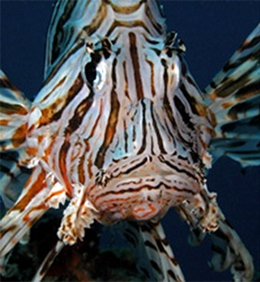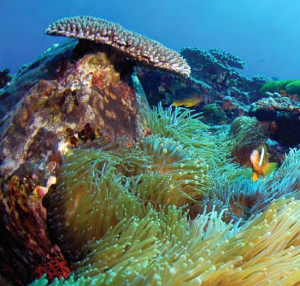The Solitary Islands Marine Park off the NSW North Coast incorporates five islands. While the southern islands are usually accessed from the Coffs Coast, the town of Wooli on the Clarence Coast is the gateway to the spectacular North Solitary Islands.
 Because the Solitary Islands are bathed by both the warm tropical waters from the north and the cooler currents from the south, a unique environment is created where tropical, subtropical and temperate marine species coexist.
Because the Solitary Islands are bathed by both the warm tropical waters from the north and the cooler currents from the south, a unique environment is created where tropical, subtropical and temperate marine species coexist.
This mixing of currents and an extensive reef habitat around the islands means the area is home to a huge diversity of marine life. To date, more than 550 species of reef fish have been seen throughout the marine park.
The North Solitaries consist of North Solitary Island and nearby North West Rock, as well as North West Solitary Island a bit further south. Pimpernel Rock is an underwater pinnacle in the area that is frequented by more experienced divers in the North Solitaries region.
Diving around the North Solitaries is popular with people keen to swim between placid grey nurse sharks, explore dark caves and see the densest concentration of anemone and anemone fish in the world.
The Northern Solitary Islands are large enough to provide a variety of diving sites, each with their own micro habitat, so depending on conditions you can go to different sheltered sites to dive.
North Solitary Island
North Solitary is only 7 nautical miles from Wooli (a 20-minute boat ride away), and has scuba diving sites with a depth between 10 and 42 metres.
Of all the islands, North Solitary Island has the highest diversity of reef fish, with thick populations at different locations around the island. It also has a high coral diversity, with over 46 species of coral found here.
 Anemone Bay, a sheltered inlet at the northern end of the Island, is particularly diverse and boasts the densest aggregation of anemones and anemone fish worldwide.
Anemone Bay, a sheltered inlet at the northern end of the Island, is particularly diverse and boasts the densest aggregation of anemones and anemone fish worldwide.
The gardens at Anemone Bay are home to myriads of these anemone fish, including the clownfish made famous in Finding Nemo.
Anywhere you look you are likely to see turtles, rays and grey nurse sharks, as well as smaller macro life such as the numerous species of nudis.
Popular diving sites at North Solitary include:
- Anemone Bay (dense anemone, anemone fish, cowries, rays, turtles)
- The Step (rocky drop-off with sharks, manta ray, giant cod, eagle and bull rays)
- The Canyons (painted crayfish, large diveable depressions in ocean floor)
- The Bubble Cave (dark cave with air bubbles, lion fish, schools of Spanish dancers)
- Fish Soup at North West Rock (variety of larger fish species including black cod, mangrove jack’s, jew fish, snapper, spangled emperor, red mowong, perl perch, mullaway and more)
Pimpernel Rock
Pimpernel Rock is an isolated underwater rock with three steep pinnacles and a large cavern of about 12 by 15 metres located some 40 metres from the surface of the ocean.
 With all kinds of sea life living in this giant shelter, Pimpernel Rock is one of the most exciting scuba diving locations on the NSW North Coast.
With all kinds of sea life living in this giant shelter, Pimpernel Rock is one of the most exciting scuba diving locations on the NSW North Coast.
Pimpernel Rock is known for its populations of large pelagics such as big kingfish and mulloway. You’ll also commonly see grey nurse sharks, particularly deeper into the cave.
The rock has sponge gardens decorating a reef that spreads from the base of each of the three pinnacles, and large rocky boulders, small trenches and overhangs as well as flat areas and step-overs.
Because of the depth of the site and the vulnerability to currents, it is an advanced dive site suitable for experienced divers in good conditions.
Getting out there
If you have all your own equipment, you can stay in Wooli and launch your boat from the Wooli Boat Ramp when the conditions are best.
Wooli Dive Centre is where you’ll find all the information you need. They also take licenced divers out on scuba diving tours to the best dive sites (minimum 4 people).
More info: